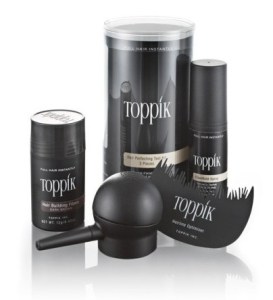TOPPIK MEDICAL REVIEW
TOPPIK MEDICAL REVIEW


TOPPIK ENHANCES PATIENT EXPERIENCE
The product is remarkably effective in achieving its stated goal.
We have observed no negative responses to Toppik (no irritation, infection, reaction, etc.) and a very high level of satisfaction.
For the past year, we have offered Toppik Hair Building Fibers to our patients to observe the product’s effectiveness as a cosmetic cover-up, and its value as part of the patient’s overall treatment.
Toppik is a “shake-on” product manufactured by Spencer Forrest, Inc., a 20-year-old company who also produces a similar product, Courve. Spencer Forrest creates products for daily use that thicken the hair and conceal any signs of scalp show- through. These products are ideal for patients immediately after transplant surgery to conceal signs of surgery or any post-operative thinning until the grafts begin to grow. They are also used to conceal hair loss for patients who are postponing surgery but want a temporary solution. They can be used in conjunction with minoxidil and Propecia® to show immediate results for patients who hope to ultimately experience an increase in hair shaft diameter and regrowth. They can also be used to supplement density in patients with very limited donor hair.
A jar of Toppik Fiber contains keratin protein fibers (derived from wool), which come in eight different colors to match most shades of hair. The fibers cling to existing hair, including the finest vellus hairs, by virtue of a static electrical charge that causes a magnet-like attraction to human hair. When shaken into a thinning area, the fibers are usually indistinguishable from real hair in appropriate candidates, even to the trained eye. While they are resistant to wind, rain, and perspiration, Toppik Fibers remove easily with any shampoo.
The product is remarkably effective in achieving its stated goal. In most cases, patients’ thinning hair immediately looks far thicker. This has been true for both men and women with a wide range of hair conditions. Post- operatively, we recommend that it not be used until crusts have formed, and may subsequently be safely applied. One of its greatest virtues is in mask- ing any post-operative thinning, and in effectively concealing any crusts or other signs of the procedure immediately post-operative.
I find it most beneficial in men and women with diffuse thinning. It is tremendously useful for patients to use during the waiting and early growth phase post-operatively (2 weeks–6 months, men; 2 weeks–8 months, women).
Because it provides immediate gratification, it is remarkable to watch the morale transformation for patients severely troubled and discouraged by their loss and yet limited in donor hair or money, or who are approach- ing their restoration with small surgical sessions over an extended period of time.
We have observed no negative responses to Toppik (no irritation, infection, reaction, etc.) and a very high level of satisfaction. We have also found this type of product to be an excellent means of maintaining contact with prospective hair trans- plant patients who are not quite ready to commit to surgery. Quite a few of these people later returned to schedule surgery after repeatedly contacting our office for reorders of Toppik.
Dr Ziering has no financial interest in Spencer Forrest products.

